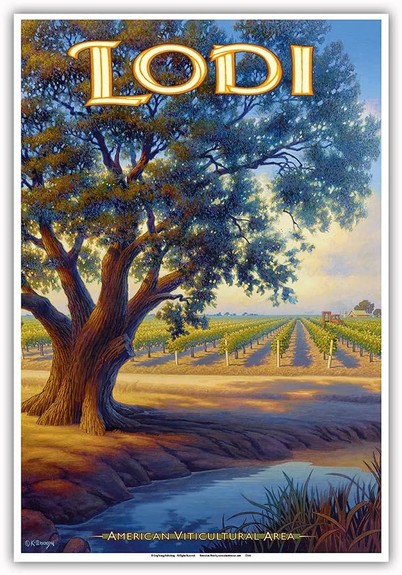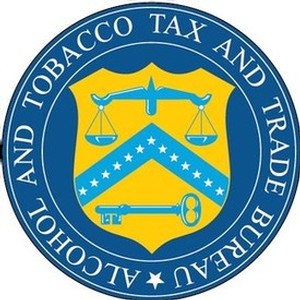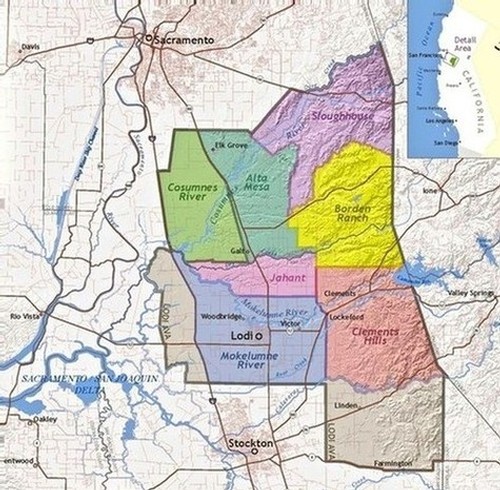Letters from Lodi
An insightful and objective look at viticulture and winemaking from the Lodi
Appellation and the growers and vintners behind these crafts. Told from the
perspective of multi-award winning wine journalist, Randy Caparoso.
A history of Lodi winegrowing, part 5 — establishment of the Lodi AVA

Kerne Erickson's artistic vision of the bucolic Lodi AVA and the region's signature, deep-rooted valley oak, native to the appellation's deep, rich sandy loam soils
Continued from: A History of Lodi winegrowing, part 4 — slow transition from co-op to independent wineries
1986 Establishment of Lodi AVA
The system of officially approved American Viticultural Areas was first established in 1978 by the ATF (Bureau of Alcohol, Tobacco, Firearms and Explosives) regulatory arm, allowing for the definition of viticultural areas within the U.S. for the purpose of controlled usage on wine labels and advertising.

Logo for the ATF division that establishes AVAs (American Viticultural Areas) upon review of petitions
Thereafter, any interested person or party could petition the ATF — today, split off as the TTB (the U.S. Department of the Treasury's Alcohol and Tobacco Tax and Trade Bureau) — to establish an AVA, providing that there is sufficient evidence to do so. Petitions must include:
• Evidence that the name of the proposed viticultural area is locally and/or nationally known as referring to the area specified in the petition.
• Historical or current evidence that the boundaries of the viticultural area are as specified in the petition.
• Evidence relating to the geographical characteristics (climate, soil elevation, topography, etc.) which distinguish the viticultural features of the proposed area from surrounding areas.

2001 depiction of the Lodi AVA from Wine Enthusiast's winemag.com, prior to the appellation's expansion of borders in 2002 and division into 7 sub-AVAs in 2006
• A description of the specific boundaries of the viticultural area, based upon features that can be found on United States Geological Survey (i.e. USGS) maps of the largest applicable scale.
• A copy of the appropriate USGS maps with the boundaries prominently mapped.
• Legally, federal law requires that 85% of any wine labeled with the name of an American Viticultural Area must come from that viticultural region.
In June of 1980, Missouri's Augusta AVA became the country’s first official viticultural area. After considerable wrangling among growers and wineries, a Napa Valley AVA was approved in early 1981. In 1982 a petition was submitted for a Lodi AVA, which was approved in 1986.

Arkansas Democrat-Gazette's free-hand mapping of the Lodi AVA (by Kelly Brant) in approximation to the Golden Gate Bridge, Yosemite, the Redwood parks, Lake Tahoe, Death Valley, and of course, Hollywood
At the time when the original 1982 petition was submitted, it was noted that the viticultural area historically known as Lodi contained approximately 39,000 acres of vineyards and 15 bonded wineries. Today, as of 2020, the Lodi AVA consists of over 100,000 acres of planted wine grapes (easily the most in the U.S.), and over 85 bonded wineries… and growing.
In the Federal Register document acknowledging the 1986 approval, the Lodi AVA is described as "an inland area that is comprised mainly of alluvial fan, flood plain lands, and lower and higher terrace lands." Its boundaries were summarized as "located in California in the counties of Sacramento and San Joaquin," with a "beginning point... located at the intersection of the Calaveras River and the San Joaquin-Stanislaus County line."

Graphic demonstrating the climatic impact of cool air sucked through the coastal mountain gap from San Francisco Bay to the Sacramento-San Joaquin River Delta — the single most significant factor defining the Lodi AVA
The Federal Register goes on to define the Lodi AVA in terms of the United States Department of Agriculture (USDA) 1937 Soil Survey of the Lodi Area: "Owing to its location opposite the wind gap leading inland from the Golden Gate, the range in temperature is narrower than in more northerly and southerly parts of the great valley (i.e. Central Valley)."

The Lodi AVA following the 2002 expansion of its borders at the west and south corners of the appellation (i.e. the gray areas on this map)
2002 Expansion of Lodi AVA
Five years after the original establishment of the Lodi AVA, in 1991 some 600 Lodi AVA growers came together to form the self-mandated Lodi-Woodbridge Wine Commission (now called the Lodi Winegrape Commission) for the purpose of regional promotion, education, and viticultural research. This would be a momentous development, playing a crucial role in Lodi’s current status as a wine-growing region of note.
In an effort to reconcile the then-existing boundaries of the Lodi AVA with the jurisdiction of the Lodi-Woodbridge Wine Commission as well as how the USDA's California Crush District 11 defined "Lodi," in 2000 a petition was submitted to the ATF to expand the Lodi AVA on its west and south sides by 93,500 acres, which at that time included an additional 9,240 acres of planted wine grapes.

California Crush Districts (the Lodi AVA brought in alignment with District 11 in 2002 expansion of appellation)
The second, expanded version of the Lodi AVA was approved in 2002. In the approved petition, the climate of the additional areas was described as having "the same moderating influences of the Sacramento Delta (i.e. Sacramento-San Joaquin River Delta) winds that define the current boundaries." Plus, the "soils of the proposed expansion area are substantially similar to those of the existing viticultural area" — derived "mainly from mixed mineral alluvium, products of weathering, erosion, and deposition along the western slope of the Sierra Nevada...
"Every significant climate feature, such as rainfall, degree-days, frost occurrence, and mean temperatures, are virtually the same within the proposed additions as those that occur inside the existing Lodi viticultural area."
Next week: A history of Lodi winegrowing, part 6 — Lodi begets seven nested AVAs

Vintage postcard depicting Flame Tokay, a table grape that, historically, could consistently attain its vivid pink color only within the Lodi AVA because of the appellation's combination of Mediterranean climate and deep (as much as 90-ft.), rich yet porous sandy loam soil